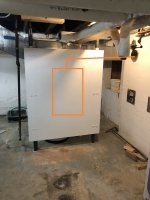PC7060
Handling one headache at a time
I have a 1928 house with original expansion tank and piping in a series-parallel configuration (2" primary and 1" and 3/4" radiator feeds). The system was last updated 30-40 years ago when a 145K BTU New Yorker gas boiler replaced an oil fuel boiler and a circulatory pump was added on the return side of the boiler. The boiler is plumbed with a direct In/Out configuration without a by-pass loop causing the boiler to routinely crash during calls for heat.
I mitigated the crashing by adding a Micro Controller (MC) in line with the thermostat low voltage heating call wiring; the MC cycles the pump off and / on based incoming water temperature to ensure the boiler temperature never goes below 140 degrees F.
The heating requirement for the house is 75K BTU based on a heat loss / load analysis of the house performed as part of the to the current renovations. The house has large radiators and heats very well at radiators temperatures of 100-120 degrees on coldest days. All radiators have been updated with Honeywell Brauman TRV.
Requirement: Remove and replace boiler, circulator pump and expansion tank.
ModCon Boiler with outdoor reset and target baseline water temperature of 120F (currently 160F).
Low flow circulator pump configured in a pumping away configuration with expansion tank. Prefer to use a Taco’s ECM high-efficiency 0015e3 or similar.
Optional: Secondary loop for DHW.
Question: looking for recommendation on boilers and equipment configuration.
Concerns: Given the age of the system the new boiler must be able to handle/mitigate "dirty" water.
Thanks in advance.
I mitigated the crashing by adding a Micro Controller (MC) in line with the thermostat low voltage heating call wiring; the MC cycles the pump off and / on based incoming water temperature to ensure the boiler temperature never goes below 140 degrees F.
The heating requirement for the house is 75K BTU based on a heat loss / load analysis of the house performed as part of the to the current renovations. The house has large radiators and heats very well at radiators temperatures of 100-120 degrees on coldest days. All radiators have been updated with Honeywell Brauman TRV.
Requirement: Remove and replace boiler, circulator pump and expansion tank.
ModCon Boiler with outdoor reset and target baseline water temperature of 120F (currently 160F).
Low flow circulator pump configured in a pumping away configuration with expansion tank. Prefer to use a Taco’s ECM high-efficiency 0015e3 or similar.
Optional: Secondary loop for DHW.
Question: looking for recommendation on boilers and equipment configuration.
Concerns: Given the age of the system the new boiler must be able to handle/mitigate "dirty" water.
Thanks in advance.

